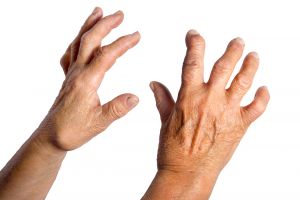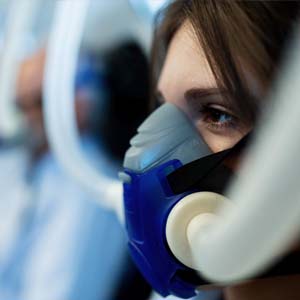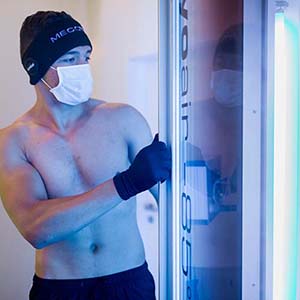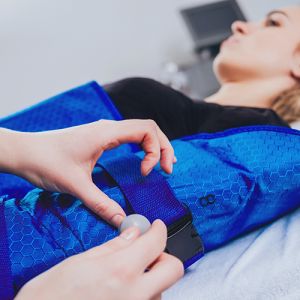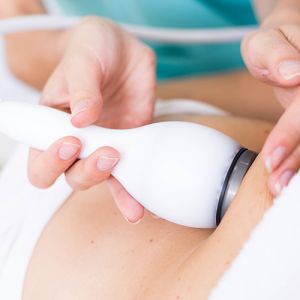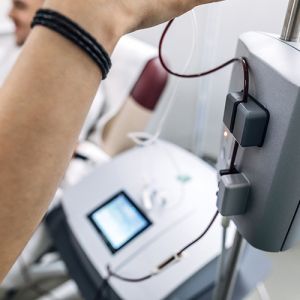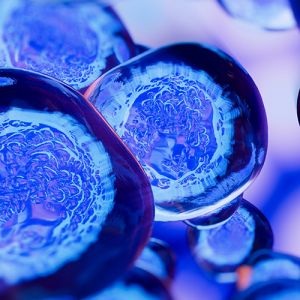Rheumatoid Arthritis
Rheumatoid Arthritis
Rheumatoid arthritis is a long-term inflammatory condition that affects more than your joints. The illness can harm a range of body systems in some people, including the skin, eyes, lungs, heart, and blood vessels.
Rheumatoid Arthritis
Rheumatoid arthritis affects about 400,000 individuals in the United Kingdom.
It usually begins when a person is between the ages of 40 and 50. Women are three times as likely than men to be affected.
The immune system of the body attacks the afflicted joints in rheumatoid arthritis, causing discomfort and swelling.
The joint’s outer coating (synovium) is the first to be impacted.
This can then spread throughout the joint, causing swelling and a change in its form. It’s possible that the bone and cartilage will break down as a result of this.
Rheumatoid arthritis patients may experience problems with different tissues and organs in their bodies.
Treatments work best when RA is detected early, so learning the indicators is crucial. Continue reading to learn everything you need to know about RA, from its causes and symptoms to home cures, diets, and other therapies.
treatment modalities to treat Rheumatoid Arthritis.
Although there is no cure for RA, there are effective medicines and treatment therapies that can help you manage the disease and avoid damage.
Rheumatoid arthritis (RA) can necessitate adjustments on the part of both patients and doctors as they work out the best ways to manage symptoms and slow the disease’s progression.
Recent advancements in treatment tactics have resulted in ever-improving rheumatoid arthritis results and quality of life. Rheumatologists use the Treat to Target treatment philosophy to effectively manage this disease.
For patients with RA, the treat-to-target approach has resulted in fewer symptoms and higher remission rates. The treatment plan includes the following steps:
- Establishing a specific testing target that indicates remission or a low disease state
- Measuring acute phase reactants and assessing treatment and management plan progress on a monthly basis
- If no progress is made, change your prescription regimen as soon as possible.
Treatments for RA help to regulate the inflammatory response and manage the pain. This can lead to remission in many circumstances. Inflammation can be reduced to help avoid further joint and organ damage.
Treatment options include:
- Medications
- Complementary and alternative therapies
- Home remedies
- Dietary changes
- Different sorts of exercises
Your healthcare professional will collaborate with you to identify the most effective treatment plan for your specific medical needs.
Many patients benefit from these therapies because they allow them to maintain an active lifestyle while reducing the risk of long-term problems.
Find out more about RA therapies and how to deal with flare-ups.
What are the symptoms of Rheumatoid Arthritis?
RA is a long-term condition that causes inflammation and pain in the joints. During flares or exacerbations, these symptoms and indications become more prominent. Periods of remission, on the other hand, are when symptoms may entirely cease.
RA symptoms most typically affect the hands, wrists, and knees, but it can also affect other tissues and organs in the body, including the lungs, heart, and eyes.
• Fatigue
• Low-grade fever
• Weakness
• Loss of appetite
• Loss of joint function and deformities
• Tenderness and swelling in more than one joint
• Stiffness in more than one joint
• Pain or aching in more than one joint
• The same joint symptoms on both sides of the body
What are the causes of rheumatoid arthritis?
RA is an autoimmune condition in which your immune system attacks healthy tissues in your body. The exact causes or triggers of RA, on the other hand, are unknown.
As part of the illness process, your immune system delivers antibodies to the lining of your joints if you have RA. These antibodies assault the tissues that line your joints, causing synovial cells to divide and cause inflammation. Chemicals are released during this process, which can harm adjacent bones, cartilage, tendons, and ligaments.
If rheumatoid arthritis is not treated, the joint will deteriorate and lose its shape and alignment, eventually leading to its destruction.
It can take a long time to diagnose RA, and it may require several lab tests to corroborate clinical examination findings. To diagnose RA, your doctor will utilise a variety of methods.
They’ll begin by inquiring about your symptoms and medical history. They’ll also give your joints a thorough examination. This will include the following:
- Swelling and redness are two things to check for
- Assessing the range of motion and joint function
- Checking for warmth and tenderness in the afflicted joints
- Looking for nodules on the skin
- testing your reflexes and muscle strength
If they suspect you have RA, they’ll most likely recommend you to a rheumatologist.
Because no one test can confirm a diagnosis of Rheumatoid Arthritis, your doctor or rheumatologist may utilise a combination of tests to confirm the diagnosis.
They may check the level of specific molecules in your blood, such as antibodies, or the level of acute phase reactants, which are high during inflammatory circumstances. These can be symptoms of RA and aid in the diagnosis.
They may also order imaging tests such as an ultrasound, X-ray, or magnetic resonance imaging (MRI).
Tests reveal not only whether or if the joint injury has occurred, but also the severity of the damage.
For some persons with Rheumatoid Arthritis, a full assessment and surveillance of other organ systems may be recommended as well.
Your healthcare physician or rheumatologist can use a variety of blood tests to assess whether you have RA. These tests include the following:
- Test for rheumatoid factor. The RF blood test looks for the rheumatoid factor, a protein that causes arthritis. Autoimmune illnesses, including RA, are linked to high levels of rheumatoid factors.
- Antibody to an anticitrullinated peptide (anti-CCP). This test checks for an antibody linked to rheumatoid arthritis. People who carry this antibody are more likely to get the disease. This antibody, however, is not seen in everyone with RA. Anti-CCP tests are more specific for RA than RF blood tests, and they are frequently positive before the RF test.
- Test for antinuclear antibodies. The antinuclear antibody panel (ANA) examines your immune system to detect if antibodies to the nucleus of cells are being produced. Many various forms of autoimmune disorders, including RA, cause your body to produce ANA antibodies.
- Sedimentation rate of erythrocytes. The ESR test might help you figure out how much inflammation is going on in your body. Your doctor will know if inflammation is present based on the results. It does not, however, reveal the origin of the inflammation or the location of the inflammation.
- The C-reactive protein test is a method of determining the amount of inflammation in the body C-reactive protein is produced by your liver when you have a serious illness or considerable inflammation anywhere in your body. RA is linked to elevated levels of this inflammatory marker.
Find out more about the different RA blood tests.
Hyperbaric oxygen therapy
for Rheumatoid Arthritis
Hyperbaric oxygen therapy reduces the joint inflammation caused by arthritis. Hyperbaric oxygen therapy boosts collagen production, which aids in the repair of cartilage that has been affected by arthritis.
Cryotherapy
for Rheumatoid Arthritis
Ozone therapy
for Rheumatoid Arthritis
Inflammation, heat, stiffness, and discomfort are all symptoms of arthritis in the joints (hands, wrists, elbows, shoulders, neck, hips, knees, ankles or feet). The goal of treatment is to alleviate these symptoms. Ozone therapy is currently one of the most successful treatments. It aids in the reduction of pain and inflammation, as well as the strengthening of the immune system, both of which are symptoms of arthritis. It also enhances the patient’s quality of life and has no adverse effects.
Red Light Therapy
for Rheumatoid Arthritis
Infrared Sauna therapy
for Rheumatoid Arthritis
Reducing inflammation is critical in the treatment of arthritis, particularly rheumatoid and psoriatic arthritis, which are both inflammatory diseases.
The anti-inflammatory effects of infrared sauna therapy have been proven in numerous studies. “A wide spectrum of immune cell investigations have indicated that exposure to infrared light most typically has an anti-inflammatory impact,” according to a large review published in 2019 by experts from Poland.
Pressotherapy
for Rheumatoid Arthritis
There are a variety of medications available to treat RA. Some of these drugs can help with RA pain and inflammation. Others aid in reducing flare-ups and limiting the joint damage caused by RA.
During RA flares, the following over-the-counter medications can help relieve pain and inflammation:
NSAIDs (nonsteroidal anti-inflammatory medicines) are medications that are used to treat (NSAIDs)
paracetamol corticosteroids (reduces pain but not inflammation)
Exercise
Get plenty of rest
During flare-ups, you may require more rest, while in remission, you may require less. Getting enough sleep will aid in the reduction of inflammation, pain, and weariness.
Apply heat or cold as needed
Cold compresses or ice packs might assist to relieve inflammation and pain, alternatively try whole body cryotherapy. They may also be useful in the treatment of muscle spasms.
Warm showers and hot compresses can be alternated with cold treatments, as are infrared sauna therapy and red light therapy. This may aid in the reduction of stiffness.
Consider using assistive technology
Splints and braces, for example, help keep your joints in a resting posture. This may assist to reduce inflammation, but it’s vital to avoid “frozen joints” by taking breaks from using them (contractors).
Even during flare-ups, canes and crutches can help you maintain mobility. In bathrooms and along stairwells, you can also add domestic equipment such as grab bars and handrails.
Learn more about these and other treatments that can help you manage your RA symptoms.
An anti-inflammatory diet may be recommended by your healthcare professional or nutritionist to aid with your symptoms. This diet consists of foods that are high in omega-3 fatty acids.
Omega-3 fatty acid-rich foods include:
- Fatty fish like salmon, tuna, herring, and mackerel
- Chia seeds
- Flax seeds
- Walnuts
Vitamins A, C, and E, as well as selenium, are antioxidants that may help reduce inflammation. Antioxidant-rich foods include:
- berries, such as blueberries, cranberries, goji berries, and strawberries
- dark chocolate
- spinach
- kidney beans
- pecans
- artichokes
It’s also crucial to eat a lot of fibre. Choose foods that are high in whole grains, fresh veggies, and fresh fruit. Strawberries have a lot of health benefits.
Flavonoids-rich foods can also aid to reduce inflammation in the body. They are as follows:
- soy products, such as tofu and miso
- berries
- green tea
- broccoli
- grapes
It’s just as important to watch what you don’t eat as it is to watch what you do consume. Make sure to stay away from foods that trigger you. Processed carbs and saturated or trans fats are examples.
When following an anti-inflammatory diet, avoiding trigger foods and choosing the correct meals will help you manage your Rheumatoid Arthritis.
Rheumatoid arthritis comes in a variety of forms. Knowing which type you have will help your doctor determine the best treatment option for you.
The following are examples of RA types:
RA that is seropositive. You have a positive rheumatoid factor or anti-CCP blood test result if you have seropositive RA. This suggests your immune system is attacking your joints due to antibodies.
RA that is Seronegative. You may have seronegative RA if you have a negative RF blood test and a negative anti-CCP blood test but still have RA symptoms. If you develop antibodies, your diagnosis will be changed to seropositive RA.
Juvenile idiopathic arthritis (JIA). RA in youngsters under the age of 17 is known as juvenile idiopathic arthritis. Rheumatoid arthritis in children and adolescents was originally classified as juvenile rheumatoid arthritis.
Seropositive rheumatoid arthritis
The most frequent kind of RA is seropositive RA. It’s possible that this sort of arthritis runs in families. Seropositive RA symptoms may be more severe than seronegative RA symptoms.
Seropositive RA symptoms can include:
- Morning stiffness that lasts at least 30 minutes
- Multiple joints are swollen and painful.
- Symmetrical joint swelling and pain
- Rheumatoid nodules
- Fever
- Fatigue
- Weight loss
The symptoms of RA aren’t necessarily limited to the joints. Inflammation of the eyes, salivary glands, nerves, kidneys, lungs, heart, skin, and blood vessels can occur in persons with seropositive RA.
Rheumatoid arthritis in the hands
- Swelling
- Redness
- Warmth
- Stiffness
Fluid-filled sacs called synovial cysts develop in the wrists, knees, elbows, ankles, and around the tiny joints of the hands as the condition advances. These cysts aren’t without risks, and tendon rupture is a possibility in some situations.
In the damaged joints, you may develop knobby growths known as bone spurs. Bone spurs can make it difficult to use your hands over time.
Your healthcare physician will work with you on exercises to help you maintain movement and function if you have RA in your hands.
Exercises, in combination with other types of treatment, can help reduce inflammation and slow disease development.
See the effects of RA manifest themselves on your hands.
What does RA look and feel like?
Your hands and feet may be the most noticeable signs of RA, especially as the disease advances and especially if you don’t have a treatment plan in place.
Fingers, wrists, knees, ankles, and toes commonly swell. A person with RA may have difficulty walking because to ligament damage and swelling in the feet.
If you don’t get therapy for RA, your hands and feet may develop serious abnormalities. A curled, claw-like appearance can be caused by deformities of the hands and fingers.
Your toes can also take on a claw-like appearance, curving upward at times and curling under the ball of your foot at other times.
On your feet, you may see ulcers, nodules, bunions, and calluses.
Rheumatoid nodules are lumps that can form anywhere on your body where joints are inflamed. They come in a variety of sizes, from extremely little to the size of a walnut or greater, and can be found in clusters.
This is how rheumatoid nodules and other apparent RA symptoms arise.
look and feel like?
Your hands and feet may be the most noticeable signs of RA, especially as the disease advances and especially if you don’t have a treatment plan in place.
Fingers, wrists, knees, ankles, and toes commonly swell. A person with RA may have difficulty walking because of ligament damage and swelling in the feet.
If you don’t get therapy for RA, your hands and feet may develop serious abnormalities. A curled, claw-like appearance can be caused by deformities of the hands and fingers.
Your toes can also take on a claw-like appearance, curving upward at times and curling under the ball of your foot at other times.
On your feet, you may see ulcers, nodules, bunions, and calluses.
Rheumatoid nodules are lumps that can form anywhere on your body where joints are inflamed. They come in a variety of sizes, from extremely little to the size of a walnut or greater, and can be found in clusters.
This is how rheumatoid nodules and other apparent RA symptoms arise.
- Age. Adults in their 50s are most likely to get RA. The risk of being assigned male at birth increases with age. RA is more common in women who were assigned female at birth and are in their child-bearing years.
- Sex. People who are born female are two to three times more likely to acquire RA than those who are born male.
- Genetics. People with specific genes, known as HLA class II genotypes, have a higher risk of developing RA. When people with these genes are obese or exposed to environmental stressors like smoking, they are more likely to develop RA.
- The number of live births throughout time. People with ovaries who have never given birth may be more likely than those who have given birth to get RA.
- Early life exposure. Children whose mothers smoked have a twofold increased chance of having RA as adults, according to the NHS.
- Smoking. People who smoke cigarettes have a higher risk of acquiring RA, according to studies.
- Obesity. Obesity can raise your chances of developing RA.
- Diet. High sodium, sugar (particularly fructose), red meat, and iron consumption have all been linked to an increased risk of getting RA.
You may be at a higher risk of developing other health problems if you have RA. Medication used to treat RA can also cause difficulties in some persons.
- Heart illness that develops too soon. People with RA are nearly twice as likely as those without the disease to have heart disease. Obesity and RA patients are at the greatest risk. Coronary artery disease is the leading cause of death among RA patients.
- Carpal tunnel syndrome is a condition that affects the hands and wrists. Carpal tunnel syndrome is very common in RA patients. In the hands and fingers, it causes soreness, numbness, or tingling. It’s caused by compression of the median nerve, which runs through the palm of the hand.
- Interstitial lung disease (ILD) is a type of lung disease that affects When your lungs become inflamed, you may develop interstitial lung disease, which is the most common pulmonary symptom of RA.
- Fibrosis of the lungs. Pulmonary fibrosis is a lung disease that produces scarring and rigidity, making breathing difficult. Pleurisy is a painful lung ailment caused by inflammation of the lung lining and is a consequence of RA (pleura).
- Pain in the chest. Pericarditis is a disorder that produces chest pain due to inflammation of the tissues surrounding the heart.
- The state of your eyes. The inflammation in the eyes caused by RA can produce uveitis and scleritis, which cause redness and pain in the eyes. It can also cause Sjögren’s syndrome, which is characterised by dry eyes.
- Vasculitis. Vasculitis is an inflammation of the blood vessels that causes them to thicken, weaken, narrow, and scar. It can disrupt blood flow to your body’s organs and be life-threatening in severe circumstances.
- Damage to the joints. If RA is not managed or treated early on, it can cause permanent joint damage. Joints can become significantly distorted, causing harm to adjacent tendons, bones, and cartilage. In some cases, surgery is required to avoid the loss of joint function.
- Cervical myelopathy is a condition that affects the nerves in the neck. If you have RA, you’re more likely to develop cervical myelopathy. The compression of the spinal cord in the neck causes this disorder. It causes dislocation of joints at the top of the spinal cord, limiting mobility and perhaps resulting in permanent spinal cord injury.
- Pneumonia. Pneumonia is the most common infection among patients who have RA.
- Renal failure is a serious condition. Renal failure is the third leading cause of death in RA patients. Chronic kidney disease (CKD) and glomerulonephritis are both more common in people with RA.
- Haemorrhage in the gastrointestinal tract. GI haemorrhage is a disorder in which the upper sections of the digestive tract bleed profusely. It’s the most prevalent GI problem among RA patients, and it’s linked to nonsteroidal anti-inflammatory medicines (NSAIDs).
- Pancytopenia. Pancytopenia is a condition in which a person’s red blood cells, white blood cells, and platelets are insufficient. It causes anaemia, leukopenia, and thrombocytopenia, which are all blood illnesses. The severity of anaemia and the severity of RA are linked.
- Lymphoma. Both Hodgkin’s lymphoma (HL) and non-lymphoma Hodgkin’s (NHL) are more common in people with RA (NHL).
- Nodules under the skin. These are skin lesions that are deep in the dermis and subcutis layers. They’re detected in 30 to 40% of RA patients, and they’re linked to more serious disorders.
Osteoarthritis (OA), like RA, causes painful and stiff joints that make it difficult to move around.
After prolonged activity, people with OA may have joint swelling, but OA does not induce a severe enough inflammatory response to cause redness in the affected joints.
OA is not an autoimmune disease like RA. It might develop as a result of trauma or as a result of natural wear and tear of the joints as you age.
The majority of people with OA are above the age of 60. It can, however, be noticed in younger adults who overuse a joint — such as tennis players and other athletes — or in those who have suffered a serious injury.
Rheumatoid arthritis (RA) is an autoimmune illness. Normal wear and tear do not produce joint deterioration caused by RA. Your body is attacking itself, which causes it.
Learn more about the differences between these two forms of arthritis.
Although rheumatoid arthritis is not a hereditary disease, it does run in some families. This could be the result of environmental factors, hereditary factors, or a combination of the two.
If you have a family member who has or has had RA, speak with your doctor, especially if you are experiencing persistent joint pain, swelling, or stiffness that isn’t caused by overuse or damage.
If you have a family history of RA, you’re more likely to have it, and early identification can make a major difference in how effective therapy is.
So, can you get RA from your parents? Perhaps — find out more here.
RA is a chronic condition for which there is presently no cure. However, most patients with RA do not experience consistent symptoms. Instead, individuals experience flare-ups followed by remissions, which are symptom-free periods.
The condition progresses differently in each person, and symptoms can range from minor to severe.
Though symptoms may go away for long periods of time, RA-related joint problems normally worsen over time. That’s why getting therapy as soon as possible will help prevent major joint injury.
Consult your doctor if you’re experiencing any symptoms or have any concerns regarding RA.
Arthritis Treatment & Therapy
Scientific Studies
Rheumatoid arthritis is a long-term inflammatory condition that affects more than your joints. The illness can harm a range of body systems in some people, including the skin, eyes, lungs, heart, and blood vessels.
Rheumatoid arthritis affects about 400,000 individuals in the United Kingdom.
It usually begins when a person is between the ages of 40 and 50. Women are three times as likely than men to be affected.
The immune system of the body attacks the afflicted joints in rheumatoid arthritis, causing discomfort and swelling.
The joint’s outer coating (synovium) is the first to be impacted.
This can then spread throughout the joint, causing swelling and a change in its form. It’s possible that the bone and cartilage will break down as a result of this.
Rheumatoid arthritis patients may experience problems with different tissues and organs in their bodies.
Treatments work best when RA is detected early, so learning the indicators is crucial. Continue reading to learn everything you need to know about RA, from its causes and symptoms to home cures, diets, and other therapies.
treatment modalities to treat Rheumatoid Arthritis.
Although there is no cure for RA, there are effective medicines and treatment therapies that can help you manage the disease and avoid damage.
Rheumatoid arthritis (RA) can necessitate adjustments on the part of both patients and doctors as they work out the best ways to manage symptoms and slow the disease’s progression.
Recent advancements in treatment tactics have resulted in ever-improving rheumatoid arthritis results and quality of life. Rheumatologists use the Treat to Target treatment philosophy to effectively manage this disease.
For patients with RA, the treat-to-target approach has resulted in fewer symptoms and higher remission rates. The treatment plan includes the following steps:
- Establishing a specific testing target that indicates remission or a low disease state
- Measuring acute phase reactants and assessing treatment and management plan progress on a monthly basis
- If no progress is made, change your prescription regimen as soon as possible.
Treatments for RA help to regulate the inflammatory response and manage the pain. This can lead to remission in many circumstances. Inflammation can be reduced to help avoid further joint and organ damage.
Treatment options include:
- Medications
- Complementary and alternative therapies
- Home remedies
- Dietary changes
- Different sorts of exercises
Your healthcare professional will collaborate with you to identify the most effective treatment plan for your specific medical needs.
Many patients benefit from these therapies because they allow them to maintain an active lifestyle while reducing the risk of long-term problems.
Find out more about RA therapies and how to deal with flare-ups.
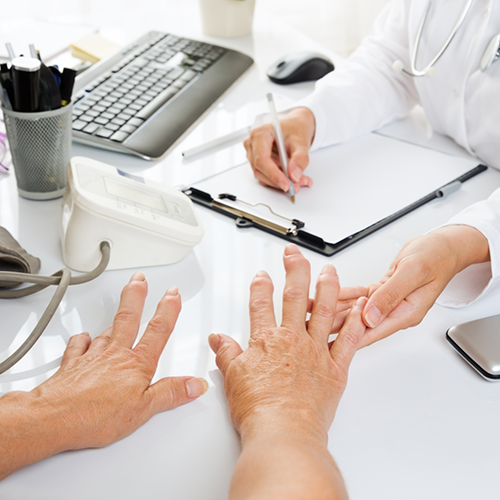
What are the symptoms of Rheumatoid Arthritis?
RA is a long-term condition that causes inflammation and pain in the joints. During flares or exacerbations, these symptoms and indications become more prominent. Periods of remission, on the other hand, are when symptoms may entirely cease.
Rheumatoid Arthritis symptoms most typically affect the hands, wrists, and knees, but it can also affect other tissues and organs in the body, including the lungs, heart, and eyes.
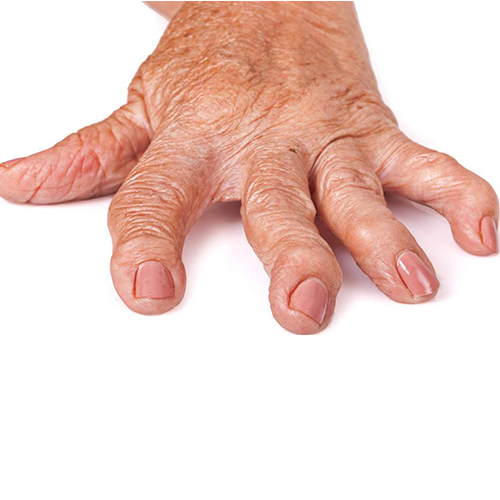
• Fatigue
• Low-grade fever
• Weakness
• Loss of appetite
• Loss of joint function and deformities
• Tenderness and swelling in more than one joint
• Stiffness in more than one joint
• Pain or aching in more than one joint
• The same joint symptoms on both sides of the body
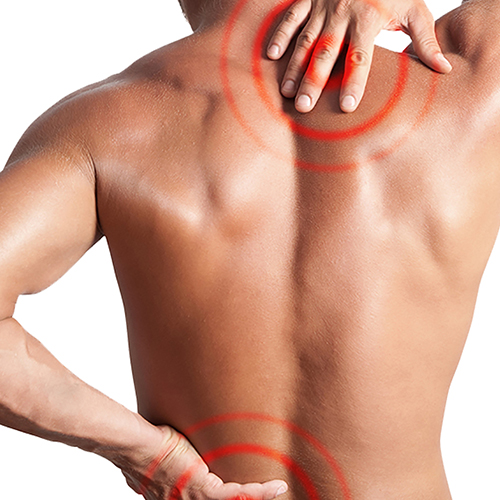
What are the causes of rheumatoid arthritis?
Rheumatoid Arthritis is an autoimmune condition in which your immune system attacks healthy tissues in your body. The exact causes or triggers of RA, on the other hand, are unknown.
As part of the illness process, your immune system delivers antibodies to the lining of your joints if you have RA. These antibodies assault the tissues that line your joints, causing synovial cells to divide and cause inflammation. Chemicals are released during this process, which can harm adjacent bones, cartilage, tendons, and ligaments.
If rheumatoid arthritis is not treated, the joint will deteriorate and lose its shape and alignment, eventually leading to its destruction.
It can take a long time to diagnose Rheumatoid Arthritis, and it may require several lab tests to corroborate clinical examination findings. To diagnose RA, your doctor will utilise a variety of methods.
They’ll begin by inquiring about your symptoms and medical history. They’ll also give your joints a thorough examination. This will include the following:
- Swelling and redness are two things to check for
- Assessing the range of motion and joint function
- Checking for warmth and tenderness in the afflicted joints
- Looking for nodules on the skin
- testing your reflexes and muscle strength
If they suspect you have RA, they’ll most likely recommend you to a rheumatologist.
Because no one test can confirm a diagnosis of RA, your doctor or rheumatologist may utilise a combination of tests to confirm the diagnosis.
They may check the level of specific molecules in your blood, such as antibodies, or the level of acute phase reactants, which are high during inflammatory circumstances. These can be symptoms of Rheumatoid Arthritis and aid in the diagnosis.
They may also order imaging tests such as an ultrasound, X-ray, or magnetic resonance imaging (MRI).
Tests reveal not only whether or if the joint injury has occurred, but also the severity of the damage.
For some persons with Rheumatoid Arthritis, a full assessment and surveillance of other organ systems may be recommended as well.
Your healthcare physician or rheumatologist can use a variety of blood tests to assess whether you have RA. These tests include the following:
- Test for rheumatoid factor. The RF blood test looks for the rheumatoid factor, a protein that causes arthritis. Autoimmune illnesses, including RA, are linked to high levels of rheumatoid factors.
- Antibody to an anticitrullinated peptide (anti-CCP). This test checks for an antibody linked to rheumatoid arthritis. People who carry this antibody are more likely to get the disease. This antibody, however, is not seen in everyone with RA. Anti-CCP tests are more specific for RA than RF blood tests, and they are frequently positive before the RF test.
- Test for antinuclear antibodies. The antinuclear antibody panel (ANA) examines your immune system to detect if antibodies to the nucleus of cells are being produced. Many various forms of autoimmune disorders, including RA, cause your body to produce ANA antibodies.
- Sedimentation rate of erythrocytes. The ESR test might help you figure out how much inflammation is going on in your body. Your doctor will know if inflammation is present based on the results. It does not, however, reveal the origin of the inflammation or the location of the inflammation.
- The C-reactive protein test is a method of determining the amount of inflammation in the body C-reactive protein is produced by your liver when you have a serious illness or considerable inflammation anywhere in your body. RA is linked to elevated levels of this inflammatory marker.
Find out more about the different RA blood tests.
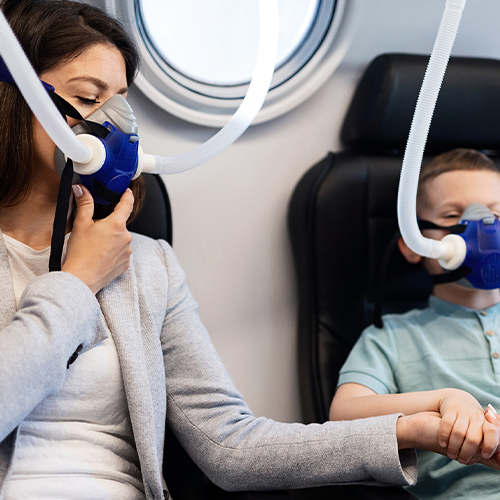
Hyperbaric oxygen therapy
for Rheumatoid Arthritis
Hyperbaric oxygen therapy reduces the joint inflammation caused by arthritis. Hyperbaric oxygen therapy boosts collagen production, which aids in the repair of cartilage that has been affected by arthritis.
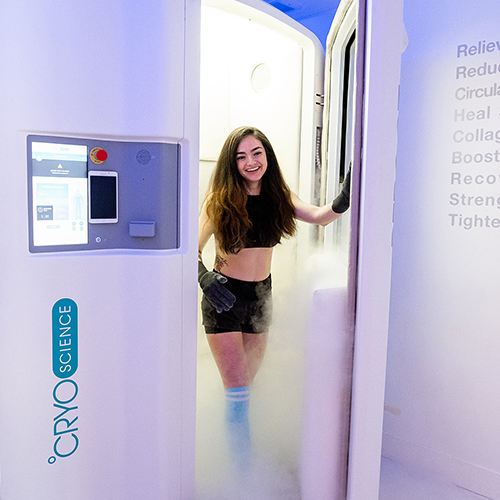
Cryotherapy
for Rheumatoid Arthritis
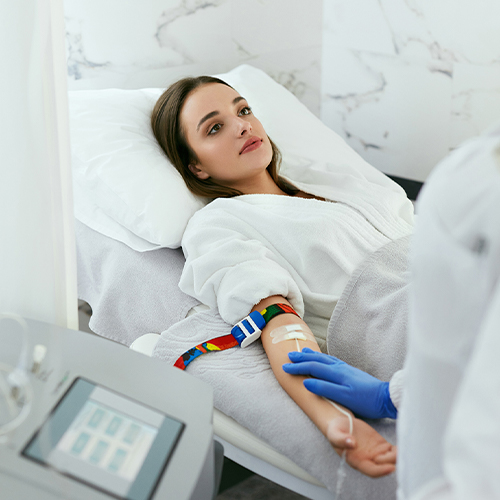
Ozone therapy
for Rheumatoid Arthritis
Inflammation, heat, stiffness, and discomfort are all symptoms of arthritis in the joints (hands, wrists, elbows, shoulders, neck, hips, knees, ankles or feet). The goal of treatment is to alleviate these symptoms. Ozone therapy is currently one of the most successful treatments. It aids in the reduction of pain and inflammation, as well as the strengthening of the immune system, both of which are symptoms of arthritis. It also enhances the patient’s quality of life and has no adverse effects.

Red Light Therapy
for Rheumatoid Arthritis

Infrared Sauna therapy
for Rheumatoid Arthritis
Reducing inflammation is critical in the treatment of arthritis, particularly rheumatoid and psoriatic arthritis, which are both inflammatory diseases.
The anti-inflammatory effects of infrared sauna therapy have been proven in numerous studies. “A wide spectrum of immune cell investigations have indicated that exposure to infrared light most typically has an anti-inflammatory impact,” according to a large review published in 2019 by experts from Poland.
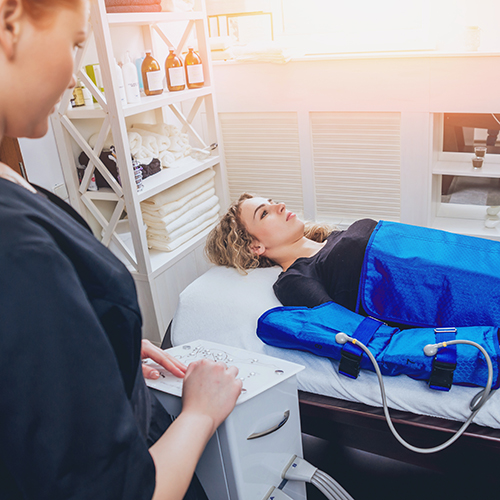
Pressotherapy
for Rheumatoid Arthritis
There are a variety of medications available to treat RA. Some of these drugs can help with RA pain and inflammation. Others aid in reducing flare-ups and limiting the joint damage caused by RA.
During RA flares, the following over-the-counter medications can help relieve pain and inflammation:
NSAIDs (nonsteroidal anti-inflammatory medicines) are medications that are used to treat (NSAIDs)
paracetamol corticosteroids (reduces pain but not inflammation)
Exercise
Get plenty of rest
During flare-ups, you may require more rest, while in remission, you may require less. Getting enough sleep will aid in the reduction of inflammation, pain, and weariness.
Apply heat or cold as needed
Cold compresses or ice packs might assist to relieve inflammation and pain, alternatively try whole body cryotherapy. They may also be useful in the treatment of muscle spasms.
Warm showers and hot compresses can be alternated with cold treatments, as are infrared sauna therapy and red light therapy. This may aid in the reduction of stiffness.
Consider using assistive technology
Splints and braces, for example, help keep your joints in a resting posture. This may assist to reduce inflammation, but it’s vital to avoid “frozen joints” by taking breaks from using them (contractors).
Even during flare-ups, canes and crutches can help you maintain mobility. In bathrooms and along stairwells, you can also add domestic equipment such as grab bars and handrails.
Learn more about these and other treatments that can help you manage your Rheumatoid Arthritis symptoms.
An anti-inflammatory diet may be recommended by your healthcare professional or nutritionist to aid with your symptoms. This diet consists of foods that are high in omega-3 fatty acids.
Omega-3 fatty acid-rich foods include:
- Fatty fish like salmon, tuna, herring, and mackerel
- Chia seeds
- Flax seeds
- Walnuts
Vitamins A, C, and E, as well as selenium, are antioxidants that may help reduce inflammation. Antioxidant-rich foods include:
- berries, such as blueberries, cranberries, goji berries, and strawberries
- dark chocolate
- spinach
- kidney beans
- pecans
- artichokes
It’s also crucial to eat a lot of fibre. Choose foods that are high in whole grains, fresh veggies, and fresh fruit. Strawberries have a lot of health benefits.
Flavonoids-rich foods can also aid to reduce inflammation in the body. They are as follows:
- soy products, such as tofu and miso
- berries
- green tea
- broccoli
- grapes
It’s just as important to watch what you don’t eat as it is to watch what you do consume. Make sure to stay away from foods that trigger you. Processed carbs and saturated or trans fats are examples.
When following an anti-inflammatory diet, avoiding trigger foods and choosing the correct meals will help you manage your RA.
Rheumatoid arthritis comes in a variety of forms. Knowing which type you have will help your doctor determine the best treatment option for you.
The following are examples of RA types:
RA that is seropositive. You have a positive rheumatoid factor or anti-CCP blood test result if you have seropositive RA. This suggests your immune system is attacking your joints due to antibodies.
RA that is Seronegative. You may have seronegative RA if you have a negative RF blood test and a negative anti-CCP blood test but still have RA symptoms. If you develop antibodies, your diagnosis will be changed to seropositive RA.
Juvenile idiopathic arthritis (JIA). RA in youngsters under the age of 17 is known as juvenile idiopathic arthritis. Rheumatoid arthritis in children and adolescents was originally classified as juvenile rheumatoid arthritis.
Seropositive rheumatoid arthritis
The most frequent kind of RA is seropositive RA. It’s possible that this sort of arthritis runs in families. Seropositive RA symptoms may be more severe than seronegative RA symptoms.
Seropositive RA symptoms can include:
- Morning stiffness that lasts at least 30 minutes
- Multiple joints are swollen and painful.
- Symmetrical joint swelling and pain
- Rheumatoid nodules
- Fever
- Fatigue
- Weight loss
The symptoms of RA aren’t necessarily limited to the joints. Inflammation of the eyes, salivary glands, nerves, kidneys, lungs, heart, skin, and blood vessels can occur in persons with seropositive RA.
Rheumatoid arthritis in the hands
- Swelling
- Redness
- Warmth
- Stiffness
Fluid-filled sacs called synovial cysts develop in the wrists, knees, elbows, ankles, and around the tiny joints of the hands as the condition advances. These cysts aren’t without risks, and tendon rupture is a possibility in some situations.
In the damaged joints, you may develop knobby growths known as bone spurs. Bone spurs can make it difficult to use your hands over time.
Your healthcare physician will work with you on exercises to help you maintain movement and function if you have RA in your hands.
Exercises, in combination with other types of treatment, can help reduce inflammation and slow disease development.
See the effects of RA manifest themselves on your hands.
What does RA look and feel like?
Your hands and feet may be the most noticeable signs of Rheumatoid Arthritis, especially as the disease advances and especially if you don’t have a treatment plan in place.
Fingers, wrists, knees, ankles, and toes commonly swell. A person with RA may have difficulty walking because to ligament damage and swelling in the feet.
If you don’t get therapy for Rheumatoid Arthritis, your hands and feet may develop serious abnormalities. A curled, claw-like appearance can be caused by deformities of the hands and fingers.
Your toes can also take on a claw-like appearance, curving upward at times and curling under the ball of your foot at other times.
On your feet, you may see ulcers, nodules, bunions, and calluses.
Rheumatoid nodules are lumps that can form anywhere on your body where joints are inflamed. They come in a variety of sizes, from extremely little to the size of a walnut or greater, and can be found in clusters.
This is how rheumatoid nodules and other apparent RA symptoms arise.
look and feel like?
Your hands and feet may be the most noticeable signs of RA, especially as the disease advances and especially if you don’t have a treatment plan in place.
Fingers, wrists, knees, ankles, and toes commonly swell. A person with RA may have difficulty walking because of ligament damage and swelling in the feet.
If you don’t get therapy for RA, your hands and feet may develop serious abnormalities. A curled, claw-like appearance can be caused by deformities of the hands and fingers.
Your toes can also take on a claw-like appearance, curving upward at times and curling under the ball of your foot at other times.
On your feet, you may see ulcers, nodules, bunions, and calluses.
Rheumatoid nodules are lumps that can form anywhere on your body where joints are inflamed. They come in a variety of sizes, from extremely little to the size of a walnut or greater, and can be found in clusters.
This is how rheumatoid nodules and other apparent RA symptoms arise.
- Age. Adults in their 50s are most likely to get RA. The risk of being assigned male at birth increases with age. RA is more common in women who were assigned female at birth and are in their child-bearing years.
- Sex. People who are born female are two to three times more likely to acquire RA than those who are born male.
- Genetics. People with specific genes, known as HLA class II genotypes, have a higher risk of developing RA. When people with these genes are obese or exposed to environmental stressors like smoking, they are more likely to develop RA.
- The number of live births throughout time. People with ovaries who have never given birth may be more likely than those who have given birth to get RA.
- Early life exposure. Children whose mothers smoked have a twofold increased chance of having RA as adults, according to the NHS.
- Smoking. People who smoke cigarettes have a higher risk of acquiring RA, according to studies.
- Obesity. Obesity can raise your chances of developing RA.
- Diet. High sodium, sugar (particularly fructose), red meat, and iron consumption have all been linked to an increased risk of getting RA.
You may be at a higher risk of developing other health problems if you have Rheumatoid Arthritis. Medication used to treat RA can also cause difficulties in some persons.
- Heart illness that develops too soon. People with Rheumatoid Arthritis are nearly twice as likely as those without the disease to have heart disease. Obesity and RA patients are at the greatest risk. Coronary artery disease is the leading cause of death among RA patients.
- Carpal tunnel syndrome is a condition that affects the hands and wrists. Carpal tunnel syndrome is very common in RA patients. In the hands and fingers, it causes soreness, numbness, or tingling. It’s caused by compression of the median nerve, which runs through the palm of the hand.
- Interstitial lung disease (ILD) is a type of lung disease that affects When your lungs become inflamed, you may develop interstitial lung disease, which is the most common pulmonary symptom of RA.
- Fibrosis of the lungs. Pulmonary fibrosis is a lung disease that produces scarring and rigidity, making breathing difficult. Pleurisy is a painful lung ailment caused by inflammation of the lung lining and is a consequence of RA (pleura).
- Pain in the chest. Pericarditis is a disorder that produces chest pain due to inflammation of the tissues surrounding the heart.
- The state of your eyes. The inflammation in the eyes caused by RA can produce uveitis and scleritis, which cause redness and pain in the eyes. It can also cause Sjögren’s syndrome, which is characterised by dry eyes.
- Vasculitis. Vasculitis is an inflammation of the blood vessels that causes them to thicken, weaken, narrow, and scar. It can disrupt blood flow to your body’s organs and be life-threatening in severe circumstances.
- Damage to the joints. If RA is not managed or treated early on, it can cause permanent joint damage. Joints can become significantly distorted, causing harm to adjacent tendons, bones, and cartilage. In some cases, surgery is required to avoid the loss of joint function.
- Cervical myelopathy is a condition that affects the nerves in the neck. If you have RA, you’re more likely to develop cervical myelopathy. The compression of the spinal cord in the neck causes this disorder. It causes dislocation of joints at the top of the spinal cord, limiting mobility and perhaps resulting in permanent spinal cord injury.
- Pneumonia. Pneumonia is the most common infection among patients who have RA.
- Renal failure is a serious condition. Renal failure is the third leading cause of death in RA patients. Chronic kidney disease (CKD) and glomerulonephritis are both more common in people with RA.
- Haemorrhage in the gastrointestinal tract. GI haemorrhage is a disorder in which the upper sections of the digestive tract bleed profusely. It’s the most prevalent GI problem among RA patients, and it’s linked to nonsteroidal anti-inflammatory medicines (NSAIDs).
- Pancytopenia. Pancytopenia is a condition in which a person’s red blood cells, white blood cells, and platelets are insufficient. It causes anaemia, leukopenia, and thrombocytopenia, which are all blood illnesses. The severity of anaemia and the severity of RA are linked.
- Lymphoma. Both Hodgkin’s lymphoma (HL) and non-lymphoma Hodgkin’s (NHL) are more common in people with RA (NHL).
- Nodules under the skin. These are skin lesions that are deep in the dermis and subcutis layers. They’re detected in 30 to 40% of RA patients, and they’re linked to more serious disorders.
Osteoarthritis (OA), like Rheumatoid Arthritis, causes painful and stiff joints that make it difficult to move around.
After prolonged activity, people with OA may have joint swelling, but OA does not induce a severe enough inflammatory response to cause redness in the affected joints.
OA is not an autoimmune disease like RA. It might develop as a result of trauma or as a result of natural wear and tear of the joints as you age.
The majority of people with OA are above the age of 60. It can, however, be noticed in younger adults who overuse a joint — such as tennis players and other athletes — or in those who have suffered a serious injury.
Rheumatoid arthritis (RA) is an autoimmune illness. Normal wear and tear do not produce joint deterioration caused by RA. Your body is attacking itself, which causes it.
Learn more about the differences between these two forms of arthritis.
Although rheumatoid arthritis is not a hereditary disease, it does run in some families. This could be the result of environmental factors, hereditary factors, or a combination of the two.
If you have a family member who has or has had RA, speak with your doctor, especially if you are experiencing persistent joint pain, swelling, or stiffness that isn’t caused by overuse or damage.
If you have a family history of RA, you’re more likely to have it, and early identification can make a major difference in how effective therapy is.
So, can you get RA from your parents? Perhaps — find out more here.
RA is a chronic condition for which there is presently no cure. However, most patients with Rheumatoid Arthritis do not experience consistent symptoms. Instead, individuals experience flare-ups followed by remissions, which are symptom-free periods.
The condition progresses differently in each person, and symptoms can range from minor to severe.
Though symptoms may go away for long periods of time, Rheumatoid Arthritis-related joint problems normally worsen over time. That’s why getting therapy as soon as possible will help prevent major joint injury.
Consult your doctor if you’re experiencing any symptoms or have any concerns regarding Rheumatoid Arthritis.


